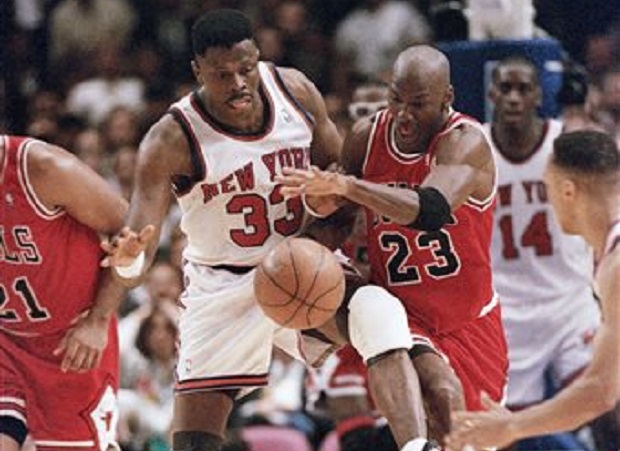
In this June 3, 1993, file photo, Chicago Bulls, Michael Jordan, right, and New York Knicks’ Patrick Ewing chase a loose ball during the second half of game 5 of the Eastern Conference finals in New York. Ewing sees the parallels between then and now. Ewing says when he played, it was mostly one superstar per team. He believes the league is heading back that way now and many say a more-balanced playing field across the NBA could be better for the league. AP
LAS VEGAS — Patrick Ewing sees the parallels between then and now.
For 13 straight seasons, Ewing averaged at least 20 points. He was a superstar, the toast of New York, the city’s biggest star when he was the face of the Knicks’ franchise. During the stretch when Ewing was at his peak, his combination of points, rebounds and blocked shots made him unquestionably one of the game’s elite.
“When I played, it was mostly one superstar per team,” Ewing said.
And that, in the end, was a problem for Ewing. For as good as he was — not to mention the likes of Charles Barkley, Dominique Wilkins, George Gervin and many others — his enormous talent never carried him to an NBA championship.
He sees the league heading back that way now. When LeBron James left Miami last week for a return to the Cleveland Cavaliers, the power structure of the league shifted as well. And while there’s obviously a team loaded with future Hall of Famers in San Antonio, and plenty of teams with two players worthy of at least superstar argument, there’s nothing now that can mirror what the Heat had when James, Dwyane Wade and Chris Bosh were teammates.
James’ latest decision also gives Cleveland a better chance to win a title.
But like Ewing, Barkley and plenty of others know, a more-balanced playing field across the NBA means many other teams figure to have a better chance as well.
“There’s a lot of money being given today and there’s a lot of teams with more great players than there were in the past,” said Paul Silas, James’ first coach in Cleveland. “I like seeing that. I really like to see the teams fight against each other and having more than one have a chance to win the whole thing.”
Welcome to the new NBA.
Or, rather, the updated NBA.
Sure, 16 teams go to the playoffs, but really, how many were legitimate title contenders last season? The entire season a year ago seemed like Indiana and Miami were preordained to meet in the Eastern Conference finals — and that’s exactly what happened. James changes sides, a few other moves get made, and now there’s probably a half-dozen teams in the East alone thinking they’ll be good enough to be one of the last two teams standing next June.
Ask NBA executives, many of whom aren’t upset to see Miami’s stranglehold as East favorites come to an end, and they say it’s all a good thing for the game.
“Much more competitive this year,” Knicks President Phil Jackson said. “The East last year, I thought until the very end when the Knicks made a run, Toronto got going, Washington got going, there were a lot of teams languishing under or around .500. But I think this year, more talent’s spread around the East and I think it’s going to be very competitive.”
The comparison might be what happened 20 years ago. Chicago was playing without Michael Jordan, who was beginning his retirement to play baseball, so the Bulls’ three-year run as NBA champions was widely expected to end. San Antonio’s David Robinson and Orlando’s Shaquille O’Neal were the league’s best two scorers that season, and neither made it out of the first round of the playoffs.
Ewing and the Knicks found their way past the Bulls — still plenty good with Scottie Pippen — and into the NBA Finals, where the MVP that season, Hakeem Olajuwon, was waiting.
The Rockets were deeper. They won in seven games, denying Ewing what was his best chance at that ring.
The lesson: Even superstars know the best team probably gets it done.
And in the East right now, who that best team is obviously up for much debate.
“Teams have the ability to have two (superstars) now,” Ewing said. “We don’t know what the collective bargaining agreement is going to be, with the new TV money coming in, what’s going to happen. We’ll see what happens.”